-
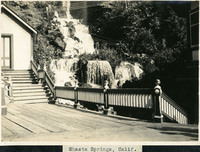 McCarthy Album 08, Photograph 170
McCarthy Album 08, Photograph 170 Caption: "Shasta Springs, Calif.," c. 1910. View of a waterfall behind a small gabled building and attached patio. Shasta Springs, just north of Dunsmuir, California, in the Trinity Mountains, was a resort area in the late nineteenth and early twentieth centuries. It centered around natural springs, which became a featured stop on the Southern Pacific Railroad's Shasta Route. The resort operated until the 1950s, when it was purchased by private interests.
-
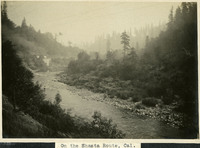 McCarthy Album 08, Photograph 169
McCarthy Album 08, Photograph 169 Caption: "On the Shasta Route, Cal.," c. 1910. Photograph likely taken from an observation car, showing a train running along a creek or river in a mountainous area. Given the caption, this is likely in the Siskiyou Mountains, Trinity Mountains, or the Cascade Range, but the specific location is unidentified.
-
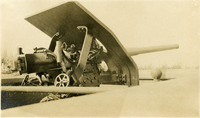 McCarthy Album 08, Photograph 168
McCarthy Album 08, Photograph 168 No Caption: c. 1910. View of a heavy coastal defense artillery gun with a shield protecting the operator of the rotating carriage in which the gun sits.
-
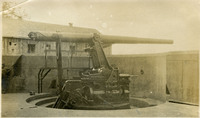 McCarthy Album 08, Photograph 167
McCarthy Album 08, Photograph 167 No Caption: c. 1910. Side view of a heavy coastal defense disappearing gun. Retracting or disappearing guns were a form of artillery developed in the nineteenth century in which heavy artillery guns were placed on rotating carriages that allowed retraction of the weapon after firing, to enable reloading while under enemy fire.
-
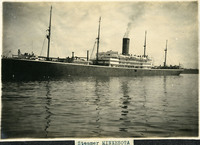 McCarthy Album 08, Photograph 166
McCarthy Album 08, Photograph 166 Caption: "Steamer MINNESOTA," c. 1909. View of the steamship Minnesota II, built in 1903. She was said to be the largest U.S. merchant ship afloat at the time. Operated by the Great Northern Steamship Company, she sailed between the U.S. and markets in Asia until 1915. In 1917 the Minnesota II began operating in the Atlantic between the U.S. and the United Kingdom. The U.S. Navy commissioned her as a troop ship in 1919, changing her name to Troy. She brought over 14,000 U.S. troops home from war-torn Europe. She never resumed active service after this, being scrapped in 1923. See also 96-07-08-alb08-111.
-
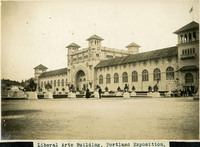 McCarthy Album 08, Photograph 165
McCarthy Album 08, Photograph 165 Caption: "Liberal Arts Building, Portland Exposition." View of the Manufactures, Liberal Arts, and Varied Industries Building at the Lewis and Clark Centennial Exposition. The exposition was held in Portland, Oregon from June 1st to October 15th, 1905. It celebrated the one-hundred year anniversary of the exploratory expedition of the Louisiana Purchase and what became the northwestern part of the United States, led by Meriwether Lewis and William Clark. Some 1.6 million people visited the fair, viewing exhibits from twenty-one countries.
-
 McCarthy Album 08, Photograph 164a
McCarthy Album 08, Photograph 164a No Caption: Pale green ribbon with red circle at the top, commemorating the participation of Japan in the Lewis and Clark Centennial Exposition. The exposition was held in Portland, Oregon from June 1st to October 15th, 1905. It celebrated the one-hundred year anniversary of the exploratory expedition of the Louisiana Purchase and what became the northwestern part of the United States, led by Meriwether Lewis and William Clark. Some 1.6 million people visited the fair, viewing exhibits from twenty-one countries.
-
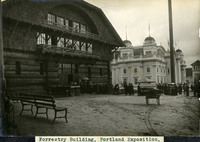 McCarthy Album 08, Photograph 164
McCarthy Album 08, Photograph 164 Caption: "Forrestry [sic] Building, Portland Exposition." View of the Forestry Building of the Lewis and Clark Centennial Exposition. Constructed of approximately one million board feet of lumber, including dozens of unpeeled, old-growth tree trunks, the building was purchased by the City of Portland after the Exposition. The building was later destroyed by fire, in 1964. The Lewis and Clark Centennial Exposition was held in Portland, Oregon from June 1st to October 15th, 1905. It celebrated the one-hundred year anniversary of the exploratory expedition of the Louisiana Purchase and what became the northwestern part of the United States, led by Meriwether Lewis and William Clark. Some 1.6 million people visited the fair, viewing exhibits from twenty-one countries.
-
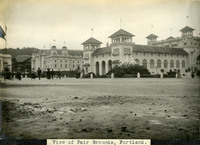 McCarthy Album 08, Photograph 163
McCarthy Album 08, Photograph 163 Caption: "View of Fair Grounds, Portland." This photograph shows several buildings of the Lewis and Clark Centennial Exposition, including the Foreign Palace (foreground), the Oriental Palace to its left, and the darkly-colored Forestry Building at the far left. The exposition was held in Portland, Oregon from June 1st to October 15th, 1905. It celebrated the one-hundred year anniversary of the exploratory expedition of the Louisiana Purchase and what became the northwestern part of the United States, led by Meriwether Lewis and William Clark. Some 1.6 million people visited the fair, viewing exhibits from twenty-one countries.
-
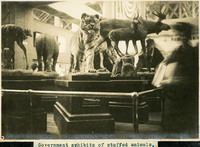 McCarthy Album 08, Photograph 162
McCarthy Album 08, Photograph 162 Caption: "Government exhibits of stuffed animals." Various mammals stuffed for display, including a tiger, moose, deer, and antelope, exhibited in the Government Building of the Lewis and Clark Centennial Exposition. The exposition was held in Portland, Oregon from June 1st to October 15th, 1905. It celebrated the one-hundred year anniversary of the exploratory expedition of the Louisiana Purchase and what became the northwestern part of the United States, led by Meriwether Lewis and William Clark. Some 1.6 million people visited the fair, viewing exhibits from twenty-one countries.
-
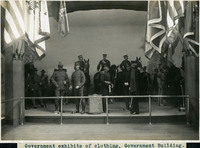 McCarthy Album 08, Photograph 161
McCarthy Album 08, Photograph 161 Caption: "Government exhibits of clothing, Government Building." This exhibit demonstrates a variety of military uniforms, displayed on mannequins. It was located in the Government Building of the Lewis and Clark Centennial Exposition, held in Portland, Oregon from June 1st to October 15th, 1905. It celebrated the one-hundred year anniversary of the exploratory expedition of the Louisiana Purchase and what became the northwestern part of the United States, led by Meriwether Lewis and William Clark. Some 1.6 million people visited the fair, viewing exhibits from twenty-one countries.
-
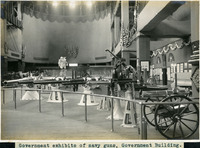 McCarthy Album 08, Photograph 160
McCarthy Album 08, Photograph 160 Caption: "Government exhibits of navy guns, Government Building." Shows a variety of naval weaponry. The exhibit was located in the Government Building of the Lewis and Clark Centennial Exposition, held in Portland, Oregon from June 1st to October 15th, 1905. The exposition celebrated the one-hundred year anniversary of the exploratory expedition of the Louisiana Purchase and what became the northwestern part of the United States, led by Meriwether Lewis and William Clark. Some 1.6 million people visited the fair, viewing exhibits from twenty-one countries.
-
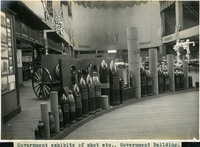 McCarthy Album 08, Photograph 159
McCarthy Album 08, Photograph 159 Caption: "Government exhibits of shot etc., Government Building." Exhibit of various types of heavy ordnance shells, including armor piercing shells as well as torpedoes. The exhibit was located in the Government Building of the Lewis and Clark Centennial Exposition, held in Portland, Oregon from June 1st to October 15th, 1905. It celebrated the one-hundred year anniversary of the exploratory expedition of the Louisiana Purchase and what became the northwestern part of the United States, led by Meriwether Lewis and William Clark. Some 1.6 million people visited the fair, viewing exhibits from twenty-one countries. See also 96-07-08-alb05-206.
-
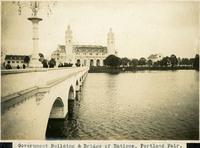 McCarthy Album 08, Photograph 158
McCarthy Album 08, Photograph 158 Caption: "Government Building & Bridge of Nations, Portland Fair." Shows the Government Building, Guild's Lake, and the Bridge of Nations, a long pedestrian bridge over the lake. Some of the more than 100,000 light bulbs used to outline the exposition's buildings can be seen along the arches and decorative molding of the bridge. The Lewis and Clark Centennial Exposition was held in Portland, Oregon from June 1st to October 15th, 1905. It celebrated the one-hundred year anniversary of the exploratory expedition of the Louisiana Purchase and what became the northwestern part of the United States, led by Meriwether Lewis and William Clark. Some 1.6 million people visited the fair, viewing exhibits from twenty-one countries. See also 96-07-08-alb05-206.
-
 McCarthy Album 08, Photograph 157a
McCarthy Album 08, Photograph 157a No Caption: Pink ribbon commemorating Agricultural Days at the Lewis and Clark Centennial Exposition (September 28 and 29, 1905). Held in Portland, Oregon, from June 1st to October 15th, 1905, the international exposition celebrated the one-hundred year anniversary of the exploratory expedition of the Louisiana Purchase and what became the northwestern part of the United States, led by Meriwether Lewis and William Clark. Some 1.6 million people visited the fair, viewing exhibits from twenty-one countries.
-
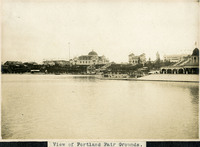 McCarthy Album 08, Photograph 157
McCarthy Album 08, Photograph 157 Caption: "View of Portland Fair Grounds." This photograph shows a panoramic view of the fair grounds where the Lewis and Clark Centennial Exposition was held in Portland, Oregon, from June 1st to October 15th, 1905. The international exposition celebrated the one-hundred year anniversary of the exploratory expedition of the Louisiana Purchase and what became the northwestern part of the United States, led by Meriwether Lewis and William Clark. Some 1.6 million people visited the fair, viewing exhibits from twenty-one countries.
-
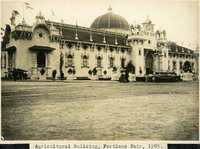 McCarthy Album 08, Photograph 156
McCarthy Album 08, Photograph 156 Caption: "Agricultural Building, Portland Fair, 1905." View of the Agriculture and Horticulture Building at the Lewis and Clark Centennial Exposition. The exposition was held in Portland, Oregon from June 1st to October 15th, 1905. It celebrated the one-hundred year anniversary of the exploratory expedition of the Louisiana Purchase and what became the northwestern part of the United States, led by Meriwether Lewis and William Clark. Some 1.6 million people visited the fair, viewing exhibits from twenty-one countries.
-
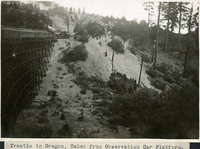 McCarthy Album 08, Photograph 155
McCarthy Album 08, Photograph 155 Caption: "Trestle in Oregon, Taken from Observation Car Platform," c. 1910. View of a train crossing a trestle in the Siskiyou Mountains of southern Oregon.
-
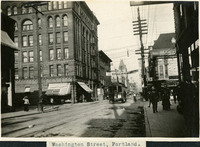 McCarthy Album 08, Photograph 154
McCarthy Album 08, Photograph 154 Caption: "Washington Street, Portland.," c. 1910. Scene on Washington Street in Portland, Oregon, featuring pedestrians, an electric trolley, and a banner noting "Republican Headquarters."
-
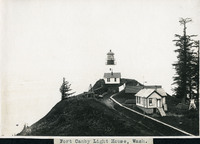 McCarthy Album 08, Photograph 153
McCarthy Album 08, Photograph 153 Caption: "Fort Canby Lighthouse, Wash.," c. 1910. View of the Cape Disappointment Lighthouse on a rocky point overlooking the mouth of the Columbia River. Cannons and cannon balls are stored on the lighthouse property. Built in the 1850s, the lighthouse was electrified in 1934 and automated in 1973. The lighthouse is now part of the Cape Disappointment State Park (formerly Fort Canby State Park).
-
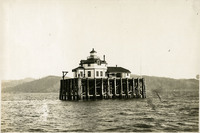 McCarthy Album 08, Photograph 152
McCarthy Album 08, Photograph 152 No Caption: c. 1910. View of the Desdemona Lighthouse, constructed in 1901 or 1902 on wood pilings over a group of shoals at the mouth of the Columbia River. The shoals carry the same name as the lighthouse, both of which are named for the bark Desdemona which ran aground and was destroyed by the shoals in 1857. The lighthouse was automated in 1934, and its light eventually removed in 1965.
-
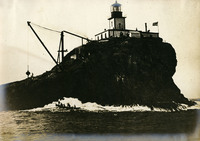 McCarthy Album 08, Photograph 151
McCarthy Album 08, Photograph 151 No Caption: c. 1898. View of Tillamook Rock Lighthouse and the small basalt rock upon which it sits, over one mile into the ocean from Tillamook Head. Built between 1880-1881, the treacherous ocean currents and often inclement weather associated with the area earned the lighthouse its nickname "Terrible Tillie" or "Tillie." This photograph was taken before the roof of the lighthouse was raised by five feet in 1898, to help prevent damage to the roof and the interior by crashing waves. The lighthouse was decommissioned in 1957.
-
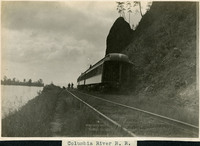 McCarthy Album 08, Photograph 150
McCarthy Album 08, Photograph 150 Caption: "Columbia River R. R.," c. 1910. View of railroad tracks along the Columbia River, with some train cars next to a high bank or cliff.
-
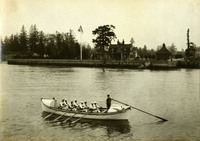 McCarthy Album 08, Photograph 149
McCarthy Album 08, Photograph 149 No Caption: c. 1910. View of the Point Adams Lifesaving Station near Hammond, Oregon, including a rowboat ("Point Adams") manned by eight rowers, with one man at the rudder. The Point Adams Lifesaving Station was established in 1889 by the federal government, in response to growing numbers of merchant, fishing, and other sailing vessels along the Columbia River. The stationhouse, visible in the center of the photograph, was demolished in 1939 to make way for a new building. The two-bay boathouse visible at the right had to be moved in 1913-1915 due to erosion of the bank upon which it stood. The U.S. Coastguard took over operation of the station in 1915. The station remained operational until 1967. The remaining buildings now house the Point Adams Research Facility of the Northwest Fisheries Science Center.
-
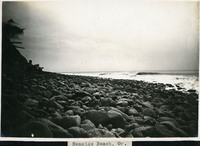 McCarthy Album 08, Photograph 148
McCarthy Album 08, Photograph 148 Caption: "Seaside Beach, Or.," undated. View of a rocky ocean beach and ocean breakers.
-
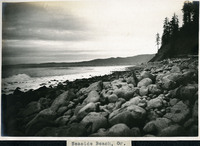 McCarthy Album 08, Photograph 147
McCarthy Album 08, Photograph 147 Caption: "Seaside Beach, Or.," undated. View of a rocky ocean beach, with hills in the distance across a small bay. Piles of driftwood appear at the right side of the photograph.
-
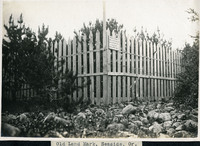 McCarthy Album 08, Photograph 146
McCarthy Album 08, Photograph 146 Caption: "Old Landmark, Seaside, Or.," c. 1910. Shows a picket fence erected around what a sign calls "Remains of Cairn where Lewis & Clark made salt from the ocean water Jan. & Feb. 1806." When the famous expedition led by Merriweather Lewis and William Clark reached the Pacific Ocean in late 1805, their supplies had run dangerously low, including their salt supply. Salt, used not only to flavor meat but also to preserve it, was extremely important to the health of the expedition. Three of Lewis and Clark's men traveled to a site on the coast near present-day Seaside, Oregon to set up a small salt-works, boiling ocean water in a series of large kettles and then scraping the resulting salt crust off of the sides. In this manner, the men eventually collected about twenty gallons of salt before Lewis and Clark decided the supply was sufficient for the return journey. In 1910, the property containing the remains of the cairns was deeded to the Oregon Historical Society. In 1955, replica salt cairns were built at the site by the Lions Club to commemorate the expedition's activities.
-
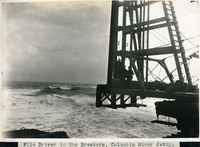 McCarthy Album 08, Photograph 145
McCarthy Album 08, Photograph 145 Caption: "Pile Driver in the Breakers, Columbia River Jetty.," c. 1910. View of a large pile driver used in the construction of the jetty system at the mouth of the Columbia River. This is likely at the end of the so-called South Jetty, extending more than six miles into the ocean from Point Adams on the Oregon side of the river mouth. The jetty system at the mouth of the Columbia River was constructed between 1885 and 1917. Designed to funnel water from the Columbia River in a more concentrated fashion into the Pacific Ocean, the jetty system helped create a deeper, more stable shipping channel.
-
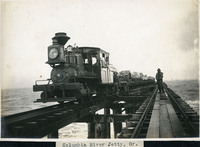 McCarthy Album 08, Photograph 144
McCarthy Album 08, Photograph 144 Caption: "Columbia River Jetty, Or.," c. 1910. View of a jetty built at the mouth of the Columbia River, carrying a railroad trestle. A train and its operators, hauling cars loaded with large rocks, dominates the photograph. This is likely the so-called South Jetty, extending more than six miles into the ocean from Point Adams on the Oregon side of the river mouth. The jetty system at the mouth of the Columbia River was constructed between 1885 and 1917. Designed to funnel water from the Columbia River in a more concentrated fashion into the Pacific Ocean, the jetty system helped create a deeper, more stable shipping channel.
-
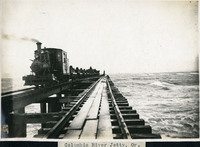 McCarthy Album 08, Photograph 143
McCarthy Album 08, Photograph 143 Caption: "Columbia River Jetty, Or.," c. 1910. View of a jetty built at the mouth of the Columbia River, carrying a railroad trestle. A train hauling cars loaded with large rocks is visible at the left side of the photograph. This is likely the so-called South Jetty, extending more than six miles into the ocean from Point Adams on the Oregon side of the river mouth. The jetty system at the mouth of the Columbia River was constructed between 1885 and 1917. Designed to funnel water from the Columbia River in a more concentrated fashion into the Pacific Ocean, the jetty system helped create a deeper, more stable shipping channel.
-
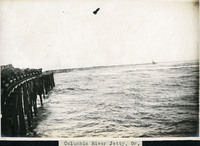 McCarthy Album 08, Photograph 142
McCarthy Album 08, Photograph 142 Caption: "Columbia River Jetty, Or.," c. 1910. View of a jetty built at the mouth of the Columbia River, carrying a railroad trestle. Train cars loaded with large rocks are visible at the left side of the photograph. This is likely the so-called South Jetty, extending more than six miles into the ocean from Point Adams on the Oregon side of the river mouth. The jetty system at the mouth of the Columbia River was constructed between 1885 and 1917. Designed to funnel water from the Columbia River in a more concentrated fashion into the Pacific Ocean, the jetty system helped create a deeper, more stable shipping channel.
-
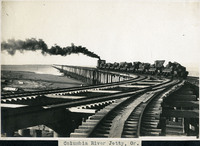 McCarthy Album 08, Photograph 141
McCarthy Album 08, Photograph 141 Caption: "Columbia River Jetty, Or.," c. 1910. View of a jetty built at the mouth of the Columbia River, carrying a railroad trestle. A train hauling cars loaded with large rocks is steaming away from the photographer. This is likely the so-called South Jetty, extending more than six miles into the ocean from Point Adams on the Oregon side of the river mouth. The jetty system at the mouth of the Columbia River was constructed between 1885 and 1917. Designed to funnel water from the Columbia River in a more concentrated fashion into the Pacific Ocean, the jetty system helped create a deeper, more stable shipping channel.
-
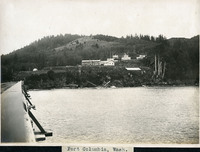 McCarthy Album 08, Photograph 140
McCarthy Album 08, Photograph 140 Caption: "Fort Columbia, Wash.," c. 1910. Fort Columbia, built between 1896 and 1904, sits on Chinook Point overlooking the Columbia River. It is part of the Three Fort Harbor Defense System protecting the mouth of the river from enemy incursion or attack (the other forts being Oregon's Fort Stevens and Washington's Fort Canby). Fort Columbia was decommissioned after World War II, and is now the site of a Washington State Park.
-
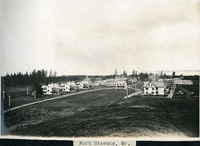 McCarthy Album 08, Photograph 139
McCarthy Album 08, Photograph 139 Caption: "Fort Stevens, Or.," c. 1910. View of buildings at Fort Stevens, part of the Three Fort Harbor Defense System protecting the mouth of the Columbia River from enemy incursion or attack (the other forts being Fort Columbia and Fort Canby, both in Washington). Built during the Civil War, the fort remained active until after World War II. In June 1942, Fort Stevens gained the dubious distinction of being the only military installation in the continental United States to come under enemy fire when a Japanese submarine surfaced off the coast and fired seventeen missiles at the fort. The missiles destroyed the backstop to the fort's baseball field, but otherwise did little harm. Fort Stevens was decommissioned in 1947. It was later turned over to the Oregon Parks and Recreation Department, and currently is the site of an Oregon State Park.
-
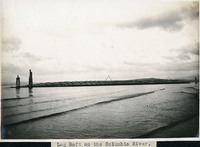 McCarthy Album 08, Photograph 138
McCarthy Album 08, Photograph 138 Caption: "Log Raft on the Columbia River.," c. 1909. View of a long raft transporting logs on the Columbia River.
-
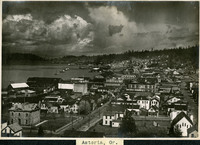 McCarthy Album 08, Photograph 137
McCarthy Album 08, Photograph 137 Caption: "Astoria, Or.," c. 1909. Bird's eye view of Astoria, a port city near the mouth of the Columbia River in Oregon.
-
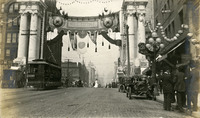 McCarthy Album 08, Photograph 136
McCarthy Album 08, Photograph 136 No Caption: Seattle street scene dominated by a banner welcoming fairgoers to the Alaska-Yukon-Pacific Exposition. Held in Seattle to celebrate the development of the Pacific Northwest, the fair attracted 3.7 million visitors over the course of its run from June to October 1909. Although most of the fair's buildings have since been destroyed, several of them now serve as part of the University of Washington campus.
-
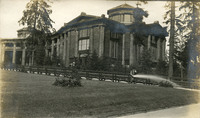 McCarthy Album 08, Photograph 135
McCarthy Album 08, Photograph 135 No Caption: View of the Forestry Building at the Alaska-Yukon-Pacific Exposition. Made out of unpeeled logs, the Forestry Building was demolished in the 1930s. Held in Seattle to celebrate the development of the Pacific Northwest, the fair attracted 3.7 million visitors over the course of its run from June to October 1909. Although most of the fair's buildings have since been destroyed, several of them now serve as part of the University of Washington campus.
-
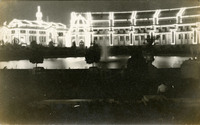 McCarthy Album 08, Photograph 134
McCarthy Album 08, Photograph 134 No Caption: This postcard shows several buildings of the Alaska-Yukon-Pacific Exposition at night, outlined by electric lights. More than 20,000 electric lights were installed on the buildings for the fair. Held in Seattle to celebrate the development of the Pacific Northwest, the fair attracted 3.7 million visitors over the course of its run from June to October 1909. Although most of the fair's buildings have since been destroyed, several of them now serve as part of the University of Washington campus.
-
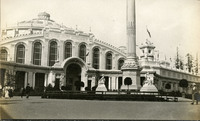 McCarthy Album 08, Photograph 133
McCarthy Album 08, Photograph 133 No Caption: This postcard shows a view of the façade of the Government Building at the Alaska-Yukon-Pacific Exposition. Held in Seattle to celebrate the development of the Pacific Northwest, the fair attracted 3.7 million visitors over the course of its run from June to October 1909. Although most of the fair's buildings have since been destroyed, several of them now serve as part of the University of Washington campus.
-
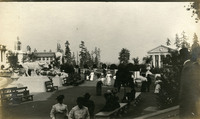 McCarthy Album 08, Photograph 132
McCarthy Album 08, Photograph 132 No Caption: View of a portion of the fairgrounds of the Alaska-Yukon-Pacific Exposition in Seattle, showing elegantly attired fairgoers strolling pathways and resting on benches. Held in Seattle to celebrate the development of the Pacific Northwest, the fair attracted 3.7 million visitors over the course of its run from June to October 1909. Although most of the fair's buildings have since been destroyed, several of them now serve as part of the University of Washington campus.
-
 McCarthy Album 08, Photograph 131
McCarthy Album 08, Photograph 131 No Caption: A statue of George Washington (Lorado Taft, artist) dominates this photograph of fair-goers at the Alaska-Yukon-Pacific Exposition. Rickshaws and their drivers rest near the statue while waiting for their next fare. Held in Seattle to celebrate the development of the Pacific Northwest, the fair attracted 3.7 million visitors over the course of its run from June to October 1909. Although most of the fair's buildings have since been destroyed, several of them now serve as part of the University of Washington campus.
-
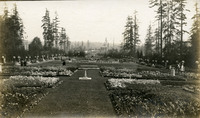 McCarthy Album 08, Photograph 130
McCarthy Album 08, Photograph 130 No Caption: View of a garden at the Alaska-Yukon-Pacific Exposition. Held in Seattle to celebrate the development of the Pacific Northwest, the fair attracted 3.7 million visitors over the course of its run from June to October 1909. Although most of the fair's buildings have since been destroyed, several of them now serve as part of the University of Washington campus.
-
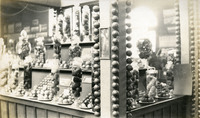 McCarthy Album 08, Photograph 129
McCarthy Album 08, Photograph 129 No Caption: Photograph of a display of lemons at the Alaska-Yukon-Pacific Exposition. Held in Seattle to celebrate the development of the Pacific Northwest, the fair attracted 3.7 million visitors over the course of its run from June to October 1909. Although most of the fair's buildings have since been destroyed, several of them now serve as part of the University of Washington campus.
-
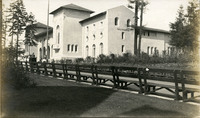 McCarthy Album 08, Photograph 128
McCarthy Album 08, Photograph 128 No Caption: View of the California Building at the Alaska-Yukon-Pacific Exposition. Held in Seattle to celebrate the development of the Pacific Northwest, the fair attracted 3.7 million visitors over the course of its run from June to October 1909. Although most of the fair's buildings have since been destroyed, several of them now serve as part of the University of Washington campus. See also 96-07-08-alb05-214.
-
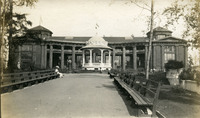 McCarthy Album 08, Photograph 127
McCarthy Album 08, Photograph 127 No Caption: View of the Forestry Building at the Alaska-Yukon-Pacific Exposition. Grace McCarthy is seated on a bench in front of the building, in a light-colored dress and hat. Made out of unpeeled logs, the Forestry Building was demolished in the 1930s. Held in Seattle to celebrate the development of the Pacific Northwest, the fair attracted 3.7 million visitors over the course of its run from June to October 1909. Although most of the fair's buildings have since been destroyed, several of them now serve as part of the University of Washington campus.
-
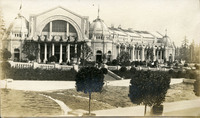 McCarthy Album 08, Photograph 126
McCarthy Album 08, Photograph 126 No Caption: View of the Manufacturing Building at the Alaska-Yukon-Pacific Exposition. Held in Seattle to celebrate the development of the Pacific Northwest, the fair attracted 3.7 million visitors over the course of its run from June to October 1909. Although most of the fair's buildings have since been destroyed, several of them now serve as part of the University of Washington campus.
-
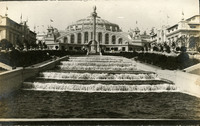 McCarthy Album 08, Photograph 125
McCarthy Album 08, Photograph 125 No Caption: This postcard shows a view of the Government Building and the Cascades (a terraced fountain leading up to the building), part of the Alaska-Yukon-Pacific Exposition. Held in Seattle to celebrate the development of the Pacific Northwest, the fair attracted 3.7 million visitors over the course of its run from June to October 1909. Although most of the fair's buildings have since been destroyed, several of them now serve as part of the University of Washington campus. See also 96-07-08-alb05-212.
-
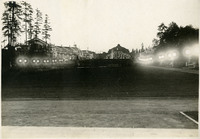 McCarthy Album 08, Photograph 124
McCarthy Album 08, Photograph 124 No Caption: View of the Alaska-Yukon-Pacific Exposition at dusk, with pathways defined by globe lights. The Government Building can be seen in the center of the photograph. Held in Seattle to celebrate the development of the Pacific Northwest, the fair attracted 3.7 million visitors over the course of its run from June to October 1909. Although most of the fair's buildings have since been destroyed, several of them now serve as part of the University of Washington campus.
-
 McCarthy Album 08, Photograph 123a
McCarthy Album 08, Photograph 123a No Caption: White ribbon commemorating Seattle Day at the Alaska-Yukon-Pacific Exposition. Held in Seattle to celebrate the development of the Pacific Northwest, the fair attracted 3.7 million visitors over the course of its run from June to October 1909. Several buildings constructed for the exposition now serve as part of the University of Washington campus.
 McCarthy Album 08, Photograph 170 Caption: "Shasta Springs, Calif.," c. 1910. View of a waterfall behind a small gabled building and attached patio. Shasta Springs, just north of Dunsmuir, California, in the Trinity Mountains, was a resort area in the late nineteenth and early twentieth centuries. It centered around natural springs, which became a featured stop on the Southern Pacific Railroad's Shasta Route. The resort operated until the 1950s, when it was purchased by private interests.
McCarthy Album 08, Photograph 170 Caption: "Shasta Springs, Calif.," c. 1910. View of a waterfall behind a small gabled building and attached patio. Shasta Springs, just north of Dunsmuir, California, in the Trinity Mountains, was a resort area in the late nineteenth and early twentieth centuries. It centered around natural springs, which became a featured stop on the Southern Pacific Railroad's Shasta Route. The resort operated until the 1950s, when it was purchased by private interests. McCarthy Album 08, Photograph 169 Caption: "On the Shasta Route, Cal.," c. 1910. Photograph likely taken from an observation car, showing a train running along a creek or river in a mountainous area. Given the caption, this is likely in the Siskiyou Mountains, Trinity Mountains, or the Cascade Range, but the specific location is unidentified.
McCarthy Album 08, Photograph 169 Caption: "On the Shasta Route, Cal.," c. 1910. Photograph likely taken from an observation car, showing a train running along a creek or river in a mountainous area. Given the caption, this is likely in the Siskiyou Mountains, Trinity Mountains, or the Cascade Range, but the specific location is unidentified. McCarthy Album 08, Photograph 168 No Caption: c. 1910. View of a heavy coastal defense artillery gun with a shield protecting the operator of the rotating carriage in which the gun sits.
McCarthy Album 08, Photograph 168 No Caption: c. 1910. View of a heavy coastal defense artillery gun with a shield protecting the operator of the rotating carriage in which the gun sits. McCarthy Album 08, Photograph 167 No Caption: c. 1910. Side view of a heavy coastal defense disappearing gun. Retracting or disappearing guns were a form of artillery developed in the nineteenth century in which heavy artillery guns were placed on rotating carriages that allowed retraction of the weapon after firing, to enable reloading while under enemy fire.
McCarthy Album 08, Photograph 167 No Caption: c. 1910. Side view of a heavy coastal defense disappearing gun. Retracting or disappearing guns were a form of artillery developed in the nineteenth century in which heavy artillery guns were placed on rotating carriages that allowed retraction of the weapon after firing, to enable reloading while under enemy fire. McCarthy Album 08, Photograph 166 Caption: "Steamer MINNESOTA," c. 1909. View of the steamship Minnesota II, built in 1903. She was said to be the largest U.S. merchant ship afloat at the time. Operated by the Great Northern Steamship Company, she sailed between the U.S. and markets in Asia until 1915. In 1917 the Minnesota II began operating in the Atlantic between the U.S. and the United Kingdom. The U.S. Navy commissioned her as a troop ship in 1919, changing her name to Troy. She brought over 14,000 U.S. troops home from war-torn Europe. She never resumed active service after this, being scrapped in 1923. See also 96-07-08-alb08-111.
McCarthy Album 08, Photograph 166 Caption: "Steamer MINNESOTA," c. 1909. View of the steamship Minnesota II, built in 1903. She was said to be the largest U.S. merchant ship afloat at the time. Operated by the Great Northern Steamship Company, she sailed between the U.S. and markets in Asia until 1915. In 1917 the Minnesota II began operating in the Atlantic between the U.S. and the United Kingdom. The U.S. Navy commissioned her as a troop ship in 1919, changing her name to Troy. She brought over 14,000 U.S. troops home from war-torn Europe. She never resumed active service after this, being scrapped in 1923. See also 96-07-08-alb08-111. McCarthy Album 08, Photograph 165 Caption: "Liberal Arts Building, Portland Exposition." View of the Manufactures, Liberal Arts, and Varied Industries Building at the Lewis and Clark Centennial Exposition. The exposition was held in Portland, Oregon from June 1st to October 15th, 1905. It celebrated the one-hundred year anniversary of the exploratory expedition of the Louisiana Purchase and what became the northwestern part of the United States, led by Meriwether Lewis and William Clark. Some 1.6 million people visited the fair, viewing exhibits from twenty-one countries.
McCarthy Album 08, Photograph 165 Caption: "Liberal Arts Building, Portland Exposition." View of the Manufactures, Liberal Arts, and Varied Industries Building at the Lewis and Clark Centennial Exposition. The exposition was held in Portland, Oregon from June 1st to October 15th, 1905. It celebrated the one-hundred year anniversary of the exploratory expedition of the Louisiana Purchase and what became the northwestern part of the United States, led by Meriwether Lewis and William Clark. Some 1.6 million people visited the fair, viewing exhibits from twenty-one countries. McCarthy Album 08, Photograph 164a No Caption: Pale green ribbon with red circle at the top, commemorating the participation of Japan in the Lewis and Clark Centennial Exposition. The exposition was held in Portland, Oregon from June 1st to October 15th, 1905. It celebrated the one-hundred year anniversary of the exploratory expedition of the Louisiana Purchase and what became the northwestern part of the United States, led by Meriwether Lewis and William Clark. Some 1.6 million people visited the fair, viewing exhibits from twenty-one countries.
McCarthy Album 08, Photograph 164a No Caption: Pale green ribbon with red circle at the top, commemorating the participation of Japan in the Lewis and Clark Centennial Exposition. The exposition was held in Portland, Oregon from June 1st to October 15th, 1905. It celebrated the one-hundred year anniversary of the exploratory expedition of the Louisiana Purchase and what became the northwestern part of the United States, led by Meriwether Lewis and William Clark. Some 1.6 million people visited the fair, viewing exhibits from twenty-one countries. McCarthy Album 08, Photograph 164 Caption: "Forrestry [sic] Building, Portland Exposition." View of the Forestry Building of the Lewis and Clark Centennial Exposition. Constructed of approximately one million board feet of lumber, including dozens of unpeeled, old-growth tree trunks, the building was purchased by the City of Portland after the Exposition. The building was later destroyed by fire, in 1964. The Lewis and Clark Centennial Exposition was held in Portland, Oregon from June 1st to October 15th, 1905. It celebrated the one-hundred year anniversary of the exploratory expedition of the Louisiana Purchase and what became the northwestern part of the United States, led by Meriwether Lewis and William Clark. Some 1.6 million people visited the fair, viewing exhibits from twenty-one countries.
McCarthy Album 08, Photograph 164 Caption: "Forrestry [sic] Building, Portland Exposition." View of the Forestry Building of the Lewis and Clark Centennial Exposition. Constructed of approximately one million board feet of lumber, including dozens of unpeeled, old-growth tree trunks, the building was purchased by the City of Portland after the Exposition. The building was later destroyed by fire, in 1964. The Lewis and Clark Centennial Exposition was held in Portland, Oregon from June 1st to October 15th, 1905. It celebrated the one-hundred year anniversary of the exploratory expedition of the Louisiana Purchase and what became the northwestern part of the United States, led by Meriwether Lewis and William Clark. Some 1.6 million people visited the fair, viewing exhibits from twenty-one countries. McCarthy Album 08, Photograph 163 Caption: "View of Fair Grounds, Portland." This photograph shows several buildings of the Lewis and Clark Centennial Exposition, including the Foreign Palace (foreground), the Oriental Palace to its left, and the darkly-colored Forestry Building at the far left. The exposition was held in Portland, Oregon from June 1st to October 15th, 1905. It celebrated the one-hundred year anniversary of the exploratory expedition of the Louisiana Purchase and what became the northwestern part of the United States, led by Meriwether Lewis and William Clark. Some 1.6 million people visited the fair, viewing exhibits from twenty-one countries.
McCarthy Album 08, Photograph 163 Caption: "View of Fair Grounds, Portland." This photograph shows several buildings of the Lewis and Clark Centennial Exposition, including the Foreign Palace (foreground), the Oriental Palace to its left, and the darkly-colored Forestry Building at the far left. The exposition was held in Portland, Oregon from June 1st to October 15th, 1905. It celebrated the one-hundred year anniversary of the exploratory expedition of the Louisiana Purchase and what became the northwestern part of the United States, led by Meriwether Lewis and William Clark. Some 1.6 million people visited the fair, viewing exhibits from twenty-one countries. McCarthy Album 08, Photograph 162 Caption: "Government exhibits of stuffed animals." Various mammals stuffed for display, including a tiger, moose, deer, and antelope, exhibited in the Government Building of the Lewis and Clark Centennial Exposition. The exposition was held in Portland, Oregon from June 1st to October 15th, 1905. It celebrated the one-hundred year anniversary of the exploratory expedition of the Louisiana Purchase and what became the northwestern part of the United States, led by Meriwether Lewis and William Clark. Some 1.6 million people visited the fair, viewing exhibits from twenty-one countries.
McCarthy Album 08, Photograph 162 Caption: "Government exhibits of stuffed animals." Various mammals stuffed for display, including a tiger, moose, deer, and antelope, exhibited in the Government Building of the Lewis and Clark Centennial Exposition. The exposition was held in Portland, Oregon from June 1st to October 15th, 1905. It celebrated the one-hundred year anniversary of the exploratory expedition of the Louisiana Purchase and what became the northwestern part of the United States, led by Meriwether Lewis and William Clark. Some 1.6 million people visited the fair, viewing exhibits from twenty-one countries. McCarthy Album 08, Photograph 161 Caption: "Government exhibits of clothing, Government Building." This exhibit demonstrates a variety of military uniforms, displayed on mannequins. It was located in the Government Building of the Lewis and Clark Centennial Exposition, held in Portland, Oregon from June 1st to October 15th, 1905. It celebrated the one-hundred year anniversary of the exploratory expedition of the Louisiana Purchase and what became the northwestern part of the United States, led by Meriwether Lewis and William Clark. Some 1.6 million people visited the fair, viewing exhibits from twenty-one countries.
McCarthy Album 08, Photograph 161 Caption: "Government exhibits of clothing, Government Building." This exhibit demonstrates a variety of military uniforms, displayed on mannequins. It was located in the Government Building of the Lewis and Clark Centennial Exposition, held in Portland, Oregon from June 1st to October 15th, 1905. It celebrated the one-hundred year anniversary of the exploratory expedition of the Louisiana Purchase and what became the northwestern part of the United States, led by Meriwether Lewis and William Clark. Some 1.6 million people visited the fair, viewing exhibits from twenty-one countries. McCarthy Album 08, Photograph 160 Caption: "Government exhibits of navy guns, Government Building." Shows a variety of naval weaponry. The exhibit was located in the Government Building of the Lewis and Clark Centennial Exposition, held in Portland, Oregon from June 1st to October 15th, 1905. The exposition celebrated the one-hundred year anniversary of the exploratory expedition of the Louisiana Purchase and what became the northwestern part of the United States, led by Meriwether Lewis and William Clark. Some 1.6 million people visited the fair, viewing exhibits from twenty-one countries.
McCarthy Album 08, Photograph 160 Caption: "Government exhibits of navy guns, Government Building." Shows a variety of naval weaponry. The exhibit was located in the Government Building of the Lewis and Clark Centennial Exposition, held in Portland, Oregon from June 1st to October 15th, 1905. The exposition celebrated the one-hundred year anniversary of the exploratory expedition of the Louisiana Purchase and what became the northwestern part of the United States, led by Meriwether Lewis and William Clark. Some 1.6 million people visited the fair, viewing exhibits from twenty-one countries. McCarthy Album 08, Photograph 159 Caption: "Government exhibits of shot etc., Government Building." Exhibit of various types of heavy ordnance shells, including armor piercing shells as well as torpedoes. The exhibit was located in the Government Building of the Lewis and Clark Centennial Exposition, held in Portland, Oregon from June 1st to October 15th, 1905. It celebrated the one-hundred year anniversary of the exploratory expedition of the Louisiana Purchase and what became the northwestern part of the United States, led by Meriwether Lewis and William Clark. Some 1.6 million people visited the fair, viewing exhibits from twenty-one countries. See also 96-07-08-alb05-206.
McCarthy Album 08, Photograph 159 Caption: "Government exhibits of shot etc., Government Building." Exhibit of various types of heavy ordnance shells, including armor piercing shells as well as torpedoes. The exhibit was located in the Government Building of the Lewis and Clark Centennial Exposition, held in Portland, Oregon from June 1st to October 15th, 1905. It celebrated the one-hundred year anniversary of the exploratory expedition of the Louisiana Purchase and what became the northwestern part of the United States, led by Meriwether Lewis and William Clark. Some 1.6 million people visited the fair, viewing exhibits from twenty-one countries. See also 96-07-08-alb05-206. McCarthy Album 08, Photograph 158 Caption: "Government Building & Bridge of Nations, Portland Fair." Shows the Government Building, Guild's Lake, and the Bridge of Nations, a long pedestrian bridge over the lake. Some of the more than 100,000 light bulbs used to outline the exposition's buildings can be seen along the arches and decorative molding of the bridge. The Lewis and Clark Centennial Exposition was held in Portland, Oregon from June 1st to October 15th, 1905. It celebrated the one-hundred year anniversary of the exploratory expedition of the Louisiana Purchase and what became the northwestern part of the United States, led by Meriwether Lewis and William Clark. Some 1.6 million people visited the fair, viewing exhibits from twenty-one countries. See also 96-07-08-alb05-206.
McCarthy Album 08, Photograph 158 Caption: "Government Building & Bridge of Nations, Portland Fair." Shows the Government Building, Guild's Lake, and the Bridge of Nations, a long pedestrian bridge over the lake. Some of the more than 100,000 light bulbs used to outline the exposition's buildings can be seen along the arches and decorative molding of the bridge. The Lewis and Clark Centennial Exposition was held in Portland, Oregon from June 1st to October 15th, 1905. It celebrated the one-hundred year anniversary of the exploratory expedition of the Louisiana Purchase and what became the northwestern part of the United States, led by Meriwether Lewis and William Clark. Some 1.6 million people visited the fair, viewing exhibits from twenty-one countries. See also 96-07-08-alb05-206. McCarthy Album 08, Photograph 157a No Caption: Pink ribbon commemorating Agricultural Days at the Lewis and Clark Centennial Exposition (September 28 and 29, 1905). Held in Portland, Oregon, from June 1st to October 15th, 1905, the international exposition celebrated the one-hundred year anniversary of the exploratory expedition of the Louisiana Purchase and what became the northwestern part of the United States, led by Meriwether Lewis and William Clark. Some 1.6 million people visited the fair, viewing exhibits from twenty-one countries.
McCarthy Album 08, Photograph 157a No Caption: Pink ribbon commemorating Agricultural Days at the Lewis and Clark Centennial Exposition (September 28 and 29, 1905). Held in Portland, Oregon, from June 1st to October 15th, 1905, the international exposition celebrated the one-hundred year anniversary of the exploratory expedition of the Louisiana Purchase and what became the northwestern part of the United States, led by Meriwether Lewis and William Clark. Some 1.6 million people visited the fair, viewing exhibits from twenty-one countries. McCarthy Album 08, Photograph 157 Caption: "View of Portland Fair Grounds." This photograph shows a panoramic view of the fair grounds where the Lewis and Clark Centennial Exposition was held in Portland, Oregon, from June 1st to October 15th, 1905. The international exposition celebrated the one-hundred year anniversary of the exploratory expedition of the Louisiana Purchase and what became the northwestern part of the United States, led by Meriwether Lewis and William Clark. Some 1.6 million people visited the fair, viewing exhibits from twenty-one countries.
McCarthy Album 08, Photograph 157 Caption: "View of Portland Fair Grounds." This photograph shows a panoramic view of the fair grounds where the Lewis and Clark Centennial Exposition was held in Portland, Oregon, from June 1st to October 15th, 1905. The international exposition celebrated the one-hundred year anniversary of the exploratory expedition of the Louisiana Purchase and what became the northwestern part of the United States, led by Meriwether Lewis and William Clark. Some 1.6 million people visited the fair, viewing exhibits from twenty-one countries. McCarthy Album 08, Photograph 156 Caption: "Agricultural Building, Portland Fair, 1905." View of the Agriculture and Horticulture Building at the Lewis and Clark Centennial Exposition. The exposition was held in Portland, Oregon from June 1st to October 15th, 1905. It celebrated the one-hundred year anniversary of the exploratory expedition of the Louisiana Purchase and what became the northwestern part of the United States, led by Meriwether Lewis and William Clark. Some 1.6 million people visited the fair, viewing exhibits from twenty-one countries.
McCarthy Album 08, Photograph 156 Caption: "Agricultural Building, Portland Fair, 1905." View of the Agriculture and Horticulture Building at the Lewis and Clark Centennial Exposition. The exposition was held in Portland, Oregon from June 1st to October 15th, 1905. It celebrated the one-hundred year anniversary of the exploratory expedition of the Louisiana Purchase and what became the northwestern part of the United States, led by Meriwether Lewis and William Clark. Some 1.6 million people visited the fair, viewing exhibits from twenty-one countries. McCarthy Album 08, Photograph 155 Caption: "Trestle in Oregon, Taken from Observation Car Platform," c. 1910. View of a train crossing a trestle in the Siskiyou Mountains of southern Oregon.
McCarthy Album 08, Photograph 155 Caption: "Trestle in Oregon, Taken from Observation Car Platform," c. 1910. View of a train crossing a trestle in the Siskiyou Mountains of southern Oregon. McCarthy Album 08, Photograph 154 Caption: "Washington Street, Portland.," c. 1910. Scene on Washington Street in Portland, Oregon, featuring pedestrians, an electric trolley, and a banner noting "Republican Headquarters."
McCarthy Album 08, Photograph 154 Caption: "Washington Street, Portland.," c. 1910. Scene on Washington Street in Portland, Oregon, featuring pedestrians, an electric trolley, and a banner noting "Republican Headquarters." McCarthy Album 08, Photograph 153 Caption: "Fort Canby Lighthouse, Wash.," c. 1910. View of the Cape Disappointment Lighthouse on a rocky point overlooking the mouth of the Columbia River. Cannons and cannon balls are stored on the lighthouse property. Built in the 1850s, the lighthouse was electrified in 1934 and automated in 1973. The lighthouse is now part of the Cape Disappointment State Park (formerly Fort Canby State Park).
McCarthy Album 08, Photograph 153 Caption: "Fort Canby Lighthouse, Wash.," c. 1910. View of the Cape Disappointment Lighthouse on a rocky point overlooking the mouth of the Columbia River. Cannons and cannon balls are stored on the lighthouse property. Built in the 1850s, the lighthouse was electrified in 1934 and automated in 1973. The lighthouse is now part of the Cape Disappointment State Park (formerly Fort Canby State Park). McCarthy Album 08, Photograph 152 No Caption: c. 1910. View of the Desdemona Lighthouse, constructed in 1901 or 1902 on wood pilings over a group of shoals at the mouth of the Columbia River. The shoals carry the same name as the lighthouse, both of which are named for the bark Desdemona which ran aground and was destroyed by the shoals in 1857. The lighthouse was automated in 1934, and its light eventually removed in 1965.
McCarthy Album 08, Photograph 152 No Caption: c. 1910. View of the Desdemona Lighthouse, constructed in 1901 or 1902 on wood pilings over a group of shoals at the mouth of the Columbia River. The shoals carry the same name as the lighthouse, both of which are named for the bark Desdemona which ran aground and was destroyed by the shoals in 1857. The lighthouse was automated in 1934, and its light eventually removed in 1965. McCarthy Album 08, Photograph 151 No Caption: c. 1898. View of Tillamook Rock Lighthouse and the small basalt rock upon which it sits, over one mile into the ocean from Tillamook Head. Built between 1880-1881, the treacherous ocean currents and often inclement weather associated with the area earned the lighthouse its nickname "Terrible Tillie" or "Tillie." This photograph was taken before the roof of the lighthouse was raised by five feet in 1898, to help prevent damage to the roof and the interior by crashing waves. The lighthouse was decommissioned in 1957.
McCarthy Album 08, Photograph 151 No Caption: c. 1898. View of Tillamook Rock Lighthouse and the small basalt rock upon which it sits, over one mile into the ocean from Tillamook Head. Built between 1880-1881, the treacherous ocean currents and often inclement weather associated with the area earned the lighthouse its nickname "Terrible Tillie" or "Tillie." This photograph was taken before the roof of the lighthouse was raised by five feet in 1898, to help prevent damage to the roof and the interior by crashing waves. The lighthouse was decommissioned in 1957. McCarthy Album 08, Photograph 150 Caption: "Columbia River R. R.," c. 1910. View of railroad tracks along the Columbia River, with some train cars next to a high bank or cliff.
McCarthy Album 08, Photograph 150 Caption: "Columbia River R. R.," c. 1910. View of railroad tracks along the Columbia River, with some train cars next to a high bank or cliff. McCarthy Album 08, Photograph 149 No Caption: c. 1910. View of the Point Adams Lifesaving Station near Hammond, Oregon, including a rowboat ("Point Adams") manned by eight rowers, with one man at the rudder. The Point Adams Lifesaving Station was established in 1889 by the federal government, in response to growing numbers of merchant, fishing, and other sailing vessels along the Columbia River. The stationhouse, visible in the center of the photograph, was demolished in 1939 to make way for a new building. The two-bay boathouse visible at the right had to be moved in 1913-1915 due to erosion of the bank upon which it stood. The U.S. Coastguard took over operation of the station in 1915. The station remained operational until 1967. The remaining buildings now house the Point Adams Research Facility of the Northwest Fisheries Science Center.
McCarthy Album 08, Photograph 149 No Caption: c. 1910. View of the Point Adams Lifesaving Station near Hammond, Oregon, including a rowboat ("Point Adams") manned by eight rowers, with one man at the rudder. The Point Adams Lifesaving Station was established in 1889 by the federal government, in response to growing numbers of merchant, fishing, and other sailing vessels along the Columbia River. The stationhouse, visible in the center of the photograph, was demolished in 1939 to make way for a new building. The two-bay boathouse visible at the right had to be moved in 1913-1915 due to erosion of the bank upon which it stood. The U.S. Coastguard took over operation of the station in 1915. The station remained operational until 1967. The remaining buildings now house the Point Adams Research Facility of the Northwest Fisheries Science Center. McCarthy Album 08, Photograph 148 Caption: "Seaside Beach, Or.," undated. View of a rocky ocean beach and ocean breakers.
McCarthy Album 08, Photograph 148 Caption: "Seaside Beach, Or.," undated. View of a rocky ocean beach and ocean breakers. McCarthy Album 08, Photograph 147 Caption: "Seaside Beach, Or.," undated. View of a rocky ocean beach, with hills in the distance across a small bay. Piles of driftwood appear at the right side of the photograph.
McCarthy Album 08, Photograph 147 Caption: "Seaside Beach, Or.," undated. View of a rocky ocean beach, with hills in the distance across a small bay. Piles of driftwood appear at the right side of the photograph. McCarthy Album 08, Photograph 146 Caption: "Old Landmark, Seaside, Or.," c. 1910. Shows a picket fence erected around what a sign calls "Remains of Cairn where Lewis & Clark made salt from the ocean water Jan. & Feb. 1806." When the famous expedition led by Merriweather Lewis and William Clark reached the Pacific Ocean in late 1805, their supplies had run dangerously low, including their salt supply. Salt, used not only to flavor meat but also to preserve it, was extremely important to the health of the expedition. Three of Lewis and Clark's men traveled to a site on the coast near present-day Seaside, Oregon to set up a small salt-works, boiling ocean water in a series of large kettles and then scraping the resulting salt crust off of the sides. In this manner, the men eventually collected about twenty gallons of salt before Lewis and Clark decided the supply was sufficient for the return journey. In 1910, the property containing the remains of the cairns was deeded to the Oregon Historical Society. In 1955, replica salt cairns were built at the site by the Lions Club to commemorate the expedition's activities.
McCarthy Album 08, Photograph 146 Caption: "Old Landmark, Seaside, Or.," c. 1910. Shows a picket fence erected around what a sign calls "Remains of Cairn where Lewis & Clark made salt from the ocean water Jan. & Feb. 1806." When the famous expedition led by Merriweather Lewis and William Clark reached the Pacific Ocean in late 1805, their supplies had run dangerously low, including their salt supply. Salt, used not only to flavor meat but also to preserve it, was extremely important to the health of the expedition. Three of Lewis and Clark's men traveled to a site on the coast near present-day Seaside, Oregon to set up a small salt-works, boiling ocean water in a series of large kettles and then scraping the resulting salt crust off of the sides. In this manner, the men eventually collected about twenty gallons of salt before Lewis and Clark decided the supply was sufficient for the return journey. In 1910, the property containing the remains of the cairns was deeded to the Oregon Historical Society. In 1955, replica salt cairns were built at the site by the Lions Club to commemorate the expedition's activities. McCarthy Album 08, Photograph 145 Caption: "Pile Driver in the Breakers, Columbia River Jetty.," c. 1910. View of a large pile driver used in the construction of the jetty system at the mouth of the Columbia River. This is likely at the end of the so-called South Jetty, extending more than six miles into the ocean from Point Adams on the Oregon side of the river mouth. The jetty system at the mouth of the Columbia River was constructed between 1885 and 1917. Designed to funnel water from the Columbia River in a more concentrated fashion into the Pacific Ocean, the jetty system helped create a deeper, more stable shipping channel.
McCarthy Album 08, Photograph 145 Caption: "Pile Driver in the Breakers, Columbia River Jetty.," c. 1910. View of a large pile driver used in the construction of the jetty system at the mouth of the Columbia River. This is likely at the end of the so-called South Jetty, extending more than six miles into the ocean from Point Adams on the Oregon side of the river mouth. The jetty system at the mouth of the Columbia River was constructed between 1885 and 1917. Designed to funnel water from the Columbia River in a more concentrated fashion into the Pacific Ocean, the jetty system helped create a deeper, more stable shipping channel. McCarthy Album 08, Photograph 144 Caption: "Columbia River Jetty, Or.," c. 1910. View of a jetty built at the mouth of the Columbia River, carrying a railroad trestle. A train and its operators, hauling cars loaded with large rocks, dominates the photograph. This is likely the so-called South Jetty, extending more than six miles into the ocean from Point Adams on the Oregon side of the river mouth. The jetty system at the mouth of the Columbia River was constructed between 1885 and 1917. Designed to funnel water from the Columbia River in a more concentrated fashion into the Pacific Ocean, the jetty system helped create a deeper, more stable shipping channel.
McCarthy Album 08, Photograph 144 Caption: "Columbia River Jetty, Or.," c. 1910. View of a jetty built at the mouth of the Columbia River, carrying a railroad trestle. A train and its operators, hauling cars loaded with large rocks, dominates the photograph. This is likely the so-called South Jetty, extending more than six miles into the ocean from Point Adams on the Oregon side of the river mouth. The jetty system at the mouth of the Columbia River was constructed between 1885 and 1917. Designed to funnel water from the Columbia River in a more concentrated fashion into the Pacific Ocean, the jetty system helped create a deeper, more stable shipping channel. McCarthy Album 08, Photograph 143 Caption: "Columbia River Jetty, Or.," c. 1910. View of a jetty built at the mouth of the Columbia River, carrying a railroad trestle. A train hauling cars loaded with large rocks is visible at the left side of the photograph. This is likely the so-called South Jetty, extending more than six miles into the ocean from Point Adams on the Oregon side of the river mouth. The jetty system at the mouth of the Columbia River was constructed between 1885 and 1917. Designed to funnel water from the Columbia River in a more concentrated fashion into the Pacific Ocean, the jetty system helped create a deeper, more stable shipping channel.
McCarthy Album 08, Photograph 143 Caption: "Columbia River Jetty, Or.," c. 1910. View of a jetty built at the mouth of the Columbia River, carrying a railroad trestle. A train hauling cars loaded with large rocks is visible at the left side of the photograph. This is likely the so-called South Jetty, extending more than six miles into the ocean from Point Adams on the Oregon side of the river mouth. The jetty system at the mouth of the Columbia River was constructed between 1885 and 1917. Designed to funnel water from the Columbia River in a more concentrated fashion into the Pacific Ocean, the jetty system helped create a deeper, more stable shipping channel. McCarthy Album 08, Photograph 142 Caption: "Columbia River Jetty, Or.," c. 1910. View of a jetty built at the mouth of the Columbia River, carrying a railroad trestle. Train cars loaded with large rocks are visible at the left side of the photograph. This is likely the so-called South Jetty, extending more than six miles into the ocean from Point Adams on the Oregon side of the river mouth. The jetty system at the mouth of the Columbia River was constructed between 1885 and 1917. Designed to funnel water from the Columbia River in a more concentrated fashion into the Pacific Ocean, the jetty system helped create a deeper, more stable shipping channel.
McCarthy Album 08, Photograph 142 Caption: "Columbia River Jetty, Or.," c. 1910. View of a jetty built at the mouth of the Columbia River, carrying a railroad trestle. Train cars loaded with large rocks are visible at the left side of the photograph. This is likely the so-called South Jetty, extending more than six miles into the ocean from Point Adams on the Oregon side of the river mouth. The jetty system at the mouth of the Columbia River was constructed between 1885 and 1917. Designed to funnel water from the Columbia River in a more concentrated fashion into the Pacific Ocean, the jetty system helped create a deeper, more stable shipping channel. McCarthy Album 08, Photograph 141 Caption: "Columbia River Jetty, Or.," c. 1910. View of a jetty built at the mouth of the Columbia River, carrying a railroad trestle. A train hauling cars loaded with large rocks is steaming away from the photographer. This is likely the so-called South Jetty, extending more than six miles into the ocean from Point Adams on the Oregon side of the river mouth. The jetty system at the mouth of the Columbia River was constructed between 1885 and 1917. Designed to funnel water from the Columbia River in a more concentrated fashion into the Pacific Ocean, the jetty system helped create a deeper, more stable shipping channel.
McCarthy Album 08, Photograph 141 Caption: "Columbia River Jetty, Or.," c. 1910. View of a jetty built at the mouth of the Columbia River, carrying a railroad trestle. A train hauling cars loaded with large rocks is steaming away from the photographer. This is likely the so-called South Jetty, extending more than six miles into the ocean from Point Adams on the Oregon side of the river mouth. The jetty system at the mouth of the Columbia River was constructed between 1885 and 1917. Designed to funnel water from the Columbia River in a more concentrated fashion into the Pacific Ocean, the jetty system helped create a deeper, more stable shipping channel. McCarthy Album 08, Photograph 140 Caption: "Fort Columbia, Wash.," c. 1910. Fort Columbia, built between 1896 and 1904, sits on Chinook Point overlooking the Columbia River. It is part of the Three Fort Harbor Defense System protecting the mouth of the river from enemy incursion or attack (the other forts being Oregon's Fort Stevens and Washington's Fort Canby). Fort Columbia was decommissioned after World War II, and is now the site of a Washington State Park.
McCarthy Album 08, Photograph 140 Caption: "Fort Columbia, Wash.," c. 1910. Fort Columbia, built between 1896 and 1904, sits on Chinook Point overlooking the Columbia River. It is part of the Three Fort Harbor Defense System protecting the mouth of the river from enemy incursion or attack (the other forts being Oregon's Fort Stevens and Washington's Fort Canby). Fort Columbia was decommissioned after World War II, and is now the site of a Washington State Park. McCarthy Album 08, Photograph 139 Caption: "Fort Stevens, Or.," c. 1910. View of buildings at Fort Stevens, part of the Three Fort Harbor Defense System protecting the mouth of the Columbia River from enemy incursion or attack (the other forts being Fort Columbia and Fort Canby, both in Washington). Built during the Civil War, the fort remained active until after World War II. In June 1942, Fort Stevens gained the dubious distinction of being the only military installation in the continental United States to come under enemy fire when a Japanese submarine surfaced off the coast and fired seventeen missiles at the fort. The missiles destroyed the backstop to the fort's baseball field, but otherwise did little harm. Fort Stevens was decommissioned in 1947. It was later turned over to the Oregon Parks and Recreation Department, and currently is the site of an Oregon State Park.
McCarthy Album 08, Photograph 139 Caption: "Fort Stevens, Or.," c. 1910. View of buildings at Fort Stevens, part of the Three Fort Harbor Defense System protecting the mouth of the Columbia River from enemy incursion or attack (the other forts being Fort Columbia and Fort Canby, both in Washington). Built during the Civil War, the fort remained active until after World War II. In June 1942, Fort Stevens gained the dubious distinction of being the only military installation in the continental United States to come under enemy fire when a Japanese submarine surfaced off the coast and fired seventeen missiles at the fort. The missiles destroyed the backstop to the fort's baseball field, but otherwise did little harm. Fort Stevens was decommissioned in 1947. It was later turned over to the Oregon Parks and Recreation Department, and currently is the site of an Oregon State Park. McCarthy Album 08, Photograph 138 Caption: "Log Raft on the Columbia River.," c. 1909. View of a long raft transporting logs on the Columbia River.
McCarthy Album 08, Photograph 138 Caption: "Log Raft on the Columbia River.," c. 1909. View of a long raft transporting logs on the Columbia River. McCarthy Album 08, Photograph 137 Caption: "Astoria, Or.," c. 1909. Bird's eye view of Astoria, a port city near the mouth of the Columbia River in Oregon.
McCarthy Album 08, Photograph 137 Caption: "Astoria, Or.," c. 1909. Bird's eye view of Astoria, a port city near the mouth of the Columbia River in Oregon. McCarthy Album 08, Photograph 136 No Caption: Seattle street scene dominated by a banner welcoming fairgoers to the Alaska-Yukon-Pacific Exposition. Held in Seattle to celebrate the development of the Pacific Northwest, the fair attracted 3.7 million visitors over the course of its run from June to October 1909. Although most of the fair's buildings have since been destroyed, several of them now serve as part of the University of Washington campus.
McCarthy Album 08, Photograph 136 No Caption: Seattle street scene dominated by a banner welcoming fairgoers to the Alaska-Yukon-Pacific Exposition. Held in Seattle to celebrate the development of the Pacific Northwest, the fair attracted 3.7 million visitors over the course of its run from June to October 1909. Although most of the fair's buildings have since been destroyed, several of them now serve as part of the University of Washington campus. McCarthy Album 08, Photograph 135 No Caption: View of the Forestry Building at the Alaska-Yukon-Pacific Exposition. Made out of unpeeled logs, the Forestry Building was demolished in the 1930s. Held in Seattle to celebrate the development of the Pacific Northwest, the fair attracted 3.7 million visitors over the course of its run from June to October 1909. Although most of the fair's buildings have since been destroyed, several of them now serve as part of the University of Washington campus.
McCarthy Album 08, Photograph 135 No Caption: View of the Forestry Building at the Alaska-Yukon-Pacific Exposition. Made out of unpeeled logs, the Forestry Building was demolished in the 1930s. Held in Seattle to celebrate the development of the Pacific Northwest, the fair attracted 3.7 million visitors over the course of its run from June to October 1909. Although most of the fair's buildings have since been destroyed, several of them now serve as part of the University of Washington campus. McCarthy Album 08, Photograph 134 No Caption: This postcard shows several buildings of the Alaska-Yukon-Pacific Exposition at night, outlined by electric lights. More than 20,000 electric lights were installed on the buildings for the fair. Held in Seattle to celebrate the development of the Pacific Northwest, the fair attracted 3.7 million visitors over the course of its run from June to October 1909. Although most of the fair's buildings have since been destroyed, several of them now serve as part of the University of Washington campus.
McCarthy Album 08, Photograph 134 No Caption: This postcard shows several buildings of the Alaska-Yukon-Pacific Exposition at night, outlined by electric lights. More than 20,000 electric lights were installed on the buildings for the fair. Held in Seattle to celebrate the development of the Pacific Northwest, the fair attracted 3.7 million visitors over the course of its run from June to October 1909. Although most of the fair's buildings have since been destroyed, several of them now serve as part of the University of Washington campus. McCarthy Album 08, Photograph 133 No Caption: This postcard shows a view of the façade of the Government Building at the Alaska-Yukon-Pacific Exposition. Held in Seattle to celebrate the development of the Pacific Northwest, the fair attracted 3.7 million visitors over the course of its run from June to October 1909. Although most of the fair's buildings have since been destroyed, several of them now serve as part of the University of Washington campus.
McCarthy Album 08, Photograph 133 No Caption: This postcard shows a view of the façade of the Government Building at the Alaska-Yukon-Pacific Exposition. Held in Seattle to celebrate the development of the Pacific Northwest, the fair attracted 3.7 million visitors over the course of its run from June to October 1909. Although most of the fair's buildings have since been destroyed, several of them now serve as part of the University of Washington campus. McCarthy Album 08, Photograph 132 No Caption: View of a portion of the fairgrounds of the Alaska-Yukon-Pacific Exposition in Seattle, showing elegantly attired fairgoers strolling pathways and resting on benches. Held in Seattle to celebrate the development of the Pacific Northwest, the fair attracted 3.7 million visitors over the course of its run from June to October 1909. Although most of the fair's buildings have since been destroyed, several of them now serve as part of the University of Washington campus.
McCarthy Album 08, Photograph 132 No Caption: View of a portion of the fairgrounds of the Alaska-Yukon-Pacific Exposition in Seattle, showing elegantly attired fairgoers strolling pathways and resting on benches. Held in Seattle to celebrate the development of the Pacific Northwest, the fair attracted 3.7 million visitors over the course of its run from June to October 1909. Although most of the fair's buildings have since been destroyed, several of them now serve as part of the University of Washington campus. McCarthy Album 08, Photograph 131 No Caption: A statue of George Washington (Lorado Taft, artist) dominates this photograph of fair-goers at the Alaska-Yukon-Pacific Exposition. Rickshaws and their drivers rest near the statue while waiting for their next fare. Held in Seattle to celebrate the development of the Pacific Northwest, the fair attracted 3.7 million visitors over the course of its run from June to October 1909. Although most of the fair's buildings have since been destroyed, several of them now serve as part of the University of Washington campus.
McCarthy Album 08, Photograph 131 No Caption: A statue of George Washington (Lorado Taft, artist) dominates this photograph of fair-goers at the Alaska-Yukon-Pacific Exposition. Rickshaws and their drivers rest near the statue while waiting for their next fare. Held in Seattle to celebrate the development of the Pacific Northwest, the fair attracted 3.7 million visitors over the course of its run from June to October 1909. Although most of the fair's buildings have since been destroyed, several of them now serve as part of the University of Washington campus. McCarthy Album 08, Photograph 130 No Caption: View of a garden at the Alaska-Yukon-Pacific Exposition. Held in Seattle to celebrate the development of the Pacific Northwest, the fair attracted 3.7 million visitors over the course of its run from June to October 1909. Although most of the fair's buildings have since been destroyed, several of them now serve as part of the University of Washington campus.
McCarthy Album 08, Photograph 130 No Caption: View of a garden at the Alaska-Yukon-Pacific Exposition. Held in Seattle to celebrate the development of the Pacific Northwest, the fair attracted 3.7 million visitors over the course of its run from June to October 1909. Although most of the fair's buildings have since been destroyed, several of them now serve as part of the University of Washington campus. McCarthy Album 08, Photograph 129 No Caption: Photograph of a display of lemons at the Alaska-Yukon-Pacific Exposition. Held in Seattle to celebrate the development of the Pacific Northwest, the fair attracted 3.7 million visitors over the course of its run from June to October 1909. Although most of the fair's buildings have since been destroyed, several of them now serve as part of the University of Washington campus.
McCarthy Album 08, Photograph 129 No Caption: Photograph of a display of lemons at the Alaska-Yukon-Pacific Exposition. Held in Seattle to celebrate the development of the Pacific Northwest, the fair attracted 3.7 million visitors over the course of its run from June to October 1909. Although most of the fair's buildings have since been destroyed, several of them now serve as part of the University of Washington campus. McCarthy Album 08, Photograph 128 No Caption: View of the California Building at the Alaska-Yukon-Pacific Exposition. Held in Seattle to celebrate the development of the Pacific Northwest, the fair attracted 3.7 million visitors over the course of its run from June to October 1909. Although most of the fair's buildings have since been destroyed, several of them now serve as part of the University of Washington campus. See also 96-07-08-alb05-214.
McCarthy Album 08, Photograph 128 No Caption: View of the California Building at the Alaska-Yukon-Pacific Exposition. Held in Seattle to celebrate the development of the Pacific Northwest, the fair attracted 3.7 million visitors over the course of its run from June to October 1909. Although most of the fair's buildings have since been destroyed, several of them now serve as part of the University of Washington campus. See also 96-07-08-alb05-214. McCarthy Album 08, Photograph 127 No Caption: View of the Forestry Building at the Alaska-Yukon-Pacific Exposition. Grace McCarthy is seated on a bench in front of the building, in a light-colored dress and hat. Made out of unpeeled logs, the Forestry Building was demolished in the 1930s. Held in Seattle to celebrate the development of the Pacific Northwest, the fair attracted 3.7 million visitors over the course of its run from June to October 1909. Although most of the fair's buildings have since been destroyed, several of them now serve as part of the University of Washington campus.
McCarthy Album 08, Photograph 127 No Caption: View of the Forestry Building at the Alaska-Yukon-Pacific Exposition. Grace McCarthy is seated on a bench in front of the building, in a light-colored dress and hat. Made out of unpeeled logs, the Forestry Building was demolished in the 1930s. Held in Seattle to celebrate the development of the Pacific Northwest, the fair attracted 3.7 million visitors over the course of its run from June to October 1909. Although most of the fair's buildings have since been destroyed, several of them now serve as part of the University of Washington campus. McCarthy Album 08, Photograph 126 No Caption: View of the Manufacturing Building at the Alaska-Yukon-Pacific Exposition. Held in Seattle to celebrate the development of the Pacific Northwest, the fair attracted 3.7 million visitors over the course of its run from June to October 1909. Although most of the fair's buildings have since been destroyed, several of them now serve as part of the University of Washington campus.
McCarthy Album 08, Photograph 126 No Caption: View of the Manufacturing Building at the Alaska-Yukon-Pacific Exposition. Held in Seattle to celebrate the development of the Pacific Northwest, the fair attracted 3.7 million visitors over the course of its run from June to October 1909. Although most of the fair's buildings have since been destroyed, several of them now serve as part of the University of Washington campus. McCarthy Album 08, Photograph 125 No Caption: This postcard shows a view of the Government Building and the Cascades (a terraced fountain leading up to the building), part of the Alaska-Yukon-Pacific Exposition. Held in Seattle to celebrate the development of the Pacific Northwest, the fair attracted 3.7 million visitors over the course of its run from June to October 1909. Although most of the fair's buildings have since been destroyed, several of them now serve as part of the University of Washington campus. See also 96-07-08-alb05-212.
McCarthy Album 08, Photograph 125 No Caption: This postcard shows a view of the Government Building and the Cascades (a terraced fountain leading up to the building), part of the Alaska-Yukon-Pacific Exposition. Held in Seattle to celebrate the development of the Pacific Northwest, the fair attracted 3.7 million visitors over the course of its run from June to October 1909. Although most of the fair's buildings have since been destroyed, several of them now serve as part of the University of Washington campus. See also 96-07-08-alb05-212. McCarthy Album 08, Photograph 124 No Caption: View of the Alaska-Yukon-Pacific Exposition at dusk, with pathways defined by globe lights. The Government Building can be seen in the center of the photograph. Held in Seattle to celebrate the development of the Pacific Northwest, the fair attracted 3.7 million visitors over the course of its run from June to October 1909. Although most of the fair's buildings have since been destroyed, several of them now serve as part of the University of Washington campus.
McCarthy Album 08, Photograph 124 No Caption: View of the Alaska-Yukon-Pacific Exposition at dusk, with pathways defined by globe lights. The Government Building can be seen in the center of the photograph. Held in Seattle to celebrate the development of the Pacific Northwest, the fair attracted 3.7 million visitors over the course of its run from June to October 1909. Although most of the fair's buildings have since been destroyed, several of them now serve as part of the University of Washington campus. McCarthy Album 08, Photograph 123a No Caption: White ribbon commemorating Seattle Day at the Alaska-Yukon-Pacific Exposition. Held in Seattle to celebrate the development of the Pacific Northwest, the fair attracted 3.7 million visitors over the course of its run from June to October 1909. Several buildings constructed for the exposition now serve as part of the University of Washington campus.
McCarthy Album 08, Photograph 123a No Caption: White ribbon commemorating Seattle Day at the Alaska-Yukon-Pacific Exposition. Held in Seattle to celebrate the development of the Pacific Northwest, the fair attracted 3.7 million visitors over the course of its run from June to October 1909. Several buildings constructed for the exposition now serve as part of the University of Washington campus.